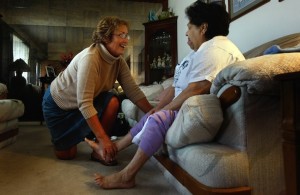Compared to the general population, African Americans are disproportionately affected by diabetes:
- 4.9 million, or 18.7 percent of all African Americans aged 20 years or older have diabetes.
- African Americans are 1.8 times more likely to have diabetes as non Hispanic whites.
Diabetes is associated with an increased risk for a number of serious, sometimes life-threatening complications, and
certain populations experience an even greater threat. Good diabetes management can help reduce your risk; however,
many people are not even aware that they have diabetes until they develop one of its complications.
- Blindness
African Americans are almost 50 percent as likely to develop diabetic retinopathy as non-Hispanic whites. - Kidney Disease
African Americans are 2.6 to 5.6 times as likely to suffer from kidney disease. - Amputations
African Americans are 2.7 times as likely to suffer from lower-limb amputations.
What is Diabetes?
Diabetes mellitus is a group of diseases characterized by high levels of blood glucose. It results from defects in insulin
secretion, insulin action, or both. Diabetes can be associated with serious complications and premature death, but
people with diabetes can take measures to reduce the likelihood of such occurrences. Most African Americans (about 90
percent to 95 percent) with diabetes have type 2 diabetes. This type of diabetes usually develops in adults and is caused
by the body’s resistance to the action of insulin and to impaired insulin secretion. It can be treated with diet, exercise,
diabetes pills, and injected insulin. A small number of African Americans (about 5 percent to 10 percent) have type 1
diabetes, which usually develops before age 20 and is always treated with insulin. Diabetes can be diagnosed by three
methods:
- A fasting plasma glucose test and a value of 126 milligrams/deciliter (mg/dL) or greater.
- A nonfasting plasma glucose value of 200 mg/dL or greater in people with symptoms of diabetes.
- An abnormal oral glucose tolerance test, with a 2-hour glucose value of 200 mg/dL or greater.
Each test must be confirmed, on another day, by any one of the above methods. The criteria used to diagnose diabetes
were revised in 1997.
How Many African Americans Have Diabetes?
 The proportion of the African American population that has diabetes rises from less than 1 percent for those aged
The proportion of the African American population that has diabetes rises from less than 1 percent for those aged
younger than 20 years to as high as 32 percent for women age 65-74 years. In every age group, prevalence is higher for
women than men: overall, among those age 20 years or older, the rate is 11.8 percent for women and 8.5 percent for men.
About one-third of total diabetes cases are undiagnosed among African Americans. This is similar to the proportion for
other racial/ethnic groups in the United States. National health surveys during the past 35 years show that the percentage of the African American population that has
been diagnosed with diabetes is increasing dramatically. The surveys in 1976-80 and in 1988-94 measured fasting plasma glucose and thus allowed an assessment of the prevalence of undiagnosed diabetes as well as of previously
diagnosed diabetes. In 1976-80, total diabetes prevalence in African Americans age 40-74 years was 8.9 percent; in 1988-94, total prevalence had increased to 18.2 percent–a doubling of the rate in just 12 years.
Prevalence in African Americans is much higher than in white Americans. Among those age 40-74 years in the 1988-94 survey, the rate was 11.2 percent for whites, but was 18.2 percent for blacks–diabetes prevalence in blacks is 1.6 times the prevalence in whites.
What Risk Factors Increase the Chance of Developing Type 2 Diabetes?
The frequency of diabetes in African American adults is influenced by the same risk factors that are associated with type 2 diabetes in other populations. Two categories of risk factors increase the chance of developing type 2 diabetes. The
first is genetics. The second is medical and lifestyle risk factors, including impaired glucose tolerance, gestational diabetes, hyperinsulinemia and insulin resistance, obesity, and physical inactivity.
Genetic Risk Factors
The common finding that “diabetes runs in families” indicates that there is a  strong genetic component to type 1 and type
strong genetic component to type 1 and type
2 diabetes. Many scientists are now conducting research to determine the genes that cause diabetes. For type 1 diabetes,
certain genes related to immunology have been implicated. For type 2 diabetes, there seem to be diabetes genes that determine insulin secretion and insulin resistance.
Some researchers believe that African Americans inherited a “thrifty gene” from their African ancestors. Years ago, this gene enabled Africans, during “feast and famine” cycles, to use food
energy more efficiently when food was scarce. Today, with fewer such cycles, the thrifty gene that developed for survival may instead make the person more susceptible to developing type 2 diabetes.
Medical Risk Factors
Impaired Glucose Tolerance (IGT)
In some people, their blood glucose level after a meal or after an oral glucose test rises higher than is considered normal but not high enough for them to be diagnosed with diabetes. These individuals are described as having impaired glucose
tolerance (IGT). IGT may be an early stage of diabetes, and people with IGT are at higher risk of developing type 2 diabetes than people with normal glucose tolerance. Rates of IGT among adults age 40-74 years in the NHANES III survey were similar for black (13 percent) and white (15 percent) Americans.2
Gestational Diabetes (GDM)
About 2 to 5 percent of pregnant women develop mild abnormalities in glucose levels and insulin secretion and are considered to have gestational diabetes. Although these women’s glucose and insulin levels often return to normal after
pregnancy, as many as 50 percent may develop type 2 diabetes within 20 years of the pregnancy.
Hyperinsulinemia and Insulin Resistance
Higher-than-normal levels of fasting insulin, called hyperinsulinemia, are associated with an increased risk of developing type 2 diabetes. Hyperinsulinemia often predates diabetes by several years.
Among people who did not have diabetes in the NHANES III survey, insulin levels were higher in African Americans than in whites, particularly African American women, indicating their greater predisposition for developing type 2 diabetes. Another study showed a higher rate of hyperinsulinemia in African American adolescents compared with white American adolescents.
Obesity
Overweight is a major risk factor for type 2 diabetes. The NHANES surveys  found that overweight is increasing in the
found that overweight is increasing in the
United States, both in adolescents and in adults. Figure 2 illustrates these data and also shows that African American
adults have substantially higher rates of obesity than white Americans.
In addition to the overall level of obesity, the location of the excess weight is also a risk factor for type 2 diabetes. Excess
weight carried above the waist is a stronger risk factor than excess weight carried below the waist. African Americans have a greater tendency to develop upper-body obesity, which increases their risk of diabetes.
Although African Americans have higher rates of obesity, researchers do not believe that obesity alone accounts for their higher prevalence of diabetes. Even when compared with white Americans with the same levels of obesity, age, and
socioeconomic status, African Americans still have higher rates of diabetes. Other factors, yet to be understood, appear to be responsible.
Physical Activity
Regular physical activity is a protective factor against type 2 diabetes and, conversely, lack of physical activity is a risk factor for developing diabetes. Researchers suspect that a lack of exercise is one factor contributing to the high rates of
diabetes in African Americans. In the NHANES III survey, 50 percent of black men and 67 percent of black women reported that they participated in little or no leisure time physical activity.
How Does Diabetes Affect African-American Young People?
African American children seem to have lower rates of type 1 diabetes than white American children. Researchers tend to agree that genetics probably makes type 1 diabetes less common among children with African ancestry compared with children of European ancestry.
How Does Diabetes Affect African American Women during Pregnancy?
Gestational diabetes, in which blood glucose values are elevated above normal during pregnancy, occurs in about 2 percent to 5 percent of all pregnant women. Perinatal problems such as macrosomia (large body size) and neonatal hypoglycemia (low blood sugar) are higher in these pregnancies.
The women generally return to normal glucose values after childbirth. However, once a woman has had gestational diabetes, she has an increased risk of developing gestational diabetes in future pregnancies.
In addition, experts estimate that about half of women with gestational diabetes develop type 2 diabetes within 20 years of the pregnancy. Several studies have shown that the occurrence of gestational diabetes in African American women may be 50 percent to 80 percent more frequent than in white women.
How Do Diabetes Complications Affect African Americans?
Compared with white Americans, African Americans experience higher rates of diabetes complications such as eye disease, kidney failure, and amputations. They also experience greater disability from these complications. Some factors
that influence the frequency of these complications, such as high blood glucose levels, abnormal blood lipids, high blood pressure, and cigarette smoking, can be influenced by proper diabetes management.
Eye Disease
Diabetic retinopathy is a deterioration of the blood vessels in the eye that is caused by high blood glucose. It can lead to impaired vision and, ultimately, to blindness. The frequency of diabetic retinopathy is 40 percent to 50 percent higher
in African Americans than in white Americans, according to NHANES III data. Retinopathy may also occur more frequently in black Americans than in whites because of their higher rate of hypertension.
Although blindness caused bydiabetic retinopathy is believed to be more frequent in blacks than in whites, there are no valid studies that compare rates of blindness between the two groups.
Kidney Failure
African Americans with diabetes experience kidney failure, also called end-stage renal disease (ESRD), about four times more often than diabetic white Americans. In 1995, there were 27,258 new cases of ESRD attributed to diabetes in black
Americans. Diabetes is the leading cause of kidney failure and accounted for 43 percent of the new cases of ESRD among black Americans during 1992-1996. Hypertension, the second leading cause of ESRD, accounted for 42 percent of cases.
In spite of their high rates of ESRD, African Americans have better survival rates after they develop kidney failure than white Americans.
Based on the U.S. hospital discharge survey, there were about 13,000 amputations among black diabetic individuals in 1994, which involved 155,000 days in the hospital.12 African Americans with diabetes are much more likely to undergo
a lower-extremity amputation than white or Hispanic Americans with diabetes. The hospitalization rate of amputations for blacks was 9.3 per 1,000 patients in 1994, compared with 5.8 per 1,000 white diabetic patients. However, the
average length of hospital stay was lower for African Americans (12.1 days) than for white Americans (16.5 days).
Does Diabetes Cause Excess Deaths in African Americans?
Diabetes was an uncommon cause of death among African Americans at the turn of the century. By 1994, however, death certificates listed diabetes as the seventh leading cause of death for African Americans. For those age 45 years or older,
it was the fifth leading cause of death. Death rates (mortality) for people with diabetes are higher for blacks than for whites. Figure 3 shows death rates for whites and blacks with diabetes in a national survey of people first studied in 1971-1975 whose mortality was confirmed
through 1992-1993.13 In every age group and for both men and women, death rates for blacks with diabetes were higher than for whites with diabetes. The overall mortality rate was 20 percent higher for black men and 40 percent higher for black women, compared with their white counterparts.
Points To Remember
- In 1993, 1.3 million African Americans were known to have diabetes. This is almost three times the number of African Americans who were diagnosed with diabetes in 1963.
- For every white American who gets diabetes, 1.6 African Americans get diabetes.
- The highest incidence of diabetes in blacks occurs between 65 and 74 years of age. Twenty-five percent of these individuals have diabetes.
- Obesity is a major medical risk factor for diabetes in African Americans,
 especially for women. Some diabetes may be prevented with weight control through healthy eating and regular exercise.
especially for women. Some diabetes may be prevented with weight control through healthy eating and regular exercise. - African Americans have higher incidence of and greater disability from diabetes complications such as kidney failure, visual impairment, and amputations.
- If African Americans can prevent, reverse, or control diabetes, their risk of complications will decrease.
- Healthy lifestyles, such as eating healthy foods and getting regular exercise, are particularly important for people who are at increased risk of diabetes
Source: National Diabetes Information Clearinghouse, National Institute of Health Sep. 1998


Speak Your Mind